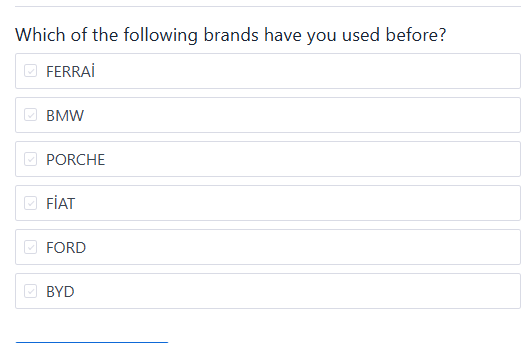Dynamic Question Types
Dynamic question types are survey questions that are shaped and customized based on users' previous responses. These questions can change according to the context of the survey, allowing for the collection of deeper and more meaningful feedback.
Use Case
Let’s say a retail company wants to report the names of products purchased by its customers and which of those products they were dissatisfied with. For example, if a customer bought lipstick, nail polish, eyeshadow, and perfume, they would be able to select the products they were unhappy with while filling out the survey. Additionally, the information about the products purchased by the customer will be visible within the feedback provided.
How It Works
Auto Tag: In this use case, product names will be taken from the system’s built-in responses. To make each product name reportable, the auto tag structure will come into play. Each product name will be automatically tagged, and this process will occur without the need for any job setup. These tags will create data for reporting.
Tags and Reporting: The incoming feedback will be displayed as automatically tagged. Tags will be grouped according to the key names written in the questions. These automatically defined tags will not appear in the tag group menu. To obtain a report, you can follow these steps:
- Select a chart type.
- Choose Measure.
- In the Compare section, select tag name.
- From the filter, select tag group. The tag group will be displayed as the keys of the defined questions.
- Generate the report.

Dynamic Multiple Choice:
All product names purchased by a customer will be stored as a built-in response within this question type. The products will be separated by commas, and only the product names will be extracted from the built-in response for the question. The key field must always be filled. (It can be populated manually via Excel or integrated through the customer schema.) The options for this question type will be filled by selecting from the data received while completing the survey. In the Advanced settings, the auto-tag feature must be enabled.



Dynamic Multiple Value:
All product names purchased by a customer will be stored as a built-in response within this question type. The products will be separated by commas, and only the product names will be extracted from the built-in response for the question. The key field must always be filled. (It can be populated manually via Excel or integrated through the customer schema.) This question type is set to "hide" by default in the survey. However, if shown, the question type and options will be displayed as read-only while completing the survey. In the Advanced settings, the auto-tag feature must be enabled.
To send a request via API for this question type, you can use the below request model:

[
{
"question":"phone_number",
"answer":"59255501022"
},
{
"question":"ProductList",
"answer":"Productname1 ProductCode1,Productname2 ProductCode2,Productname3 ProductCode3",
"dynamic":true
}
]
Every individual data must be seperated with a comma.